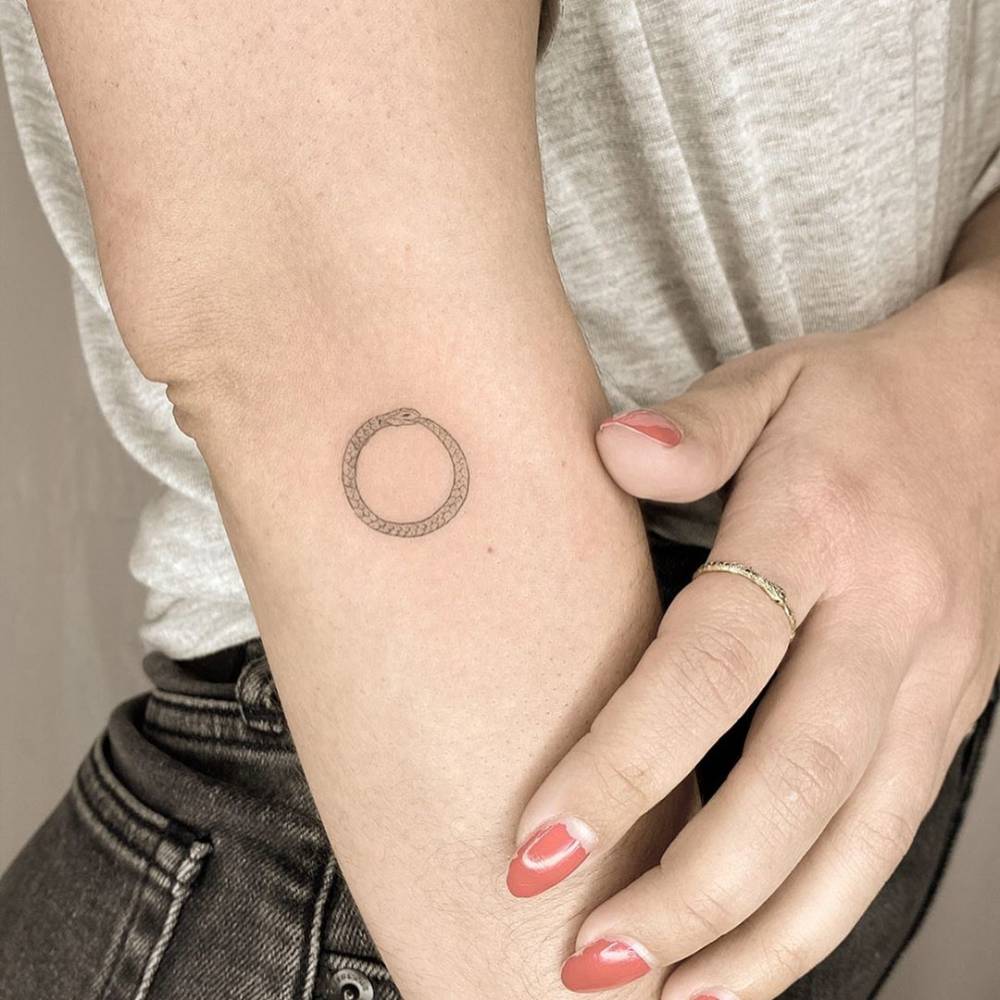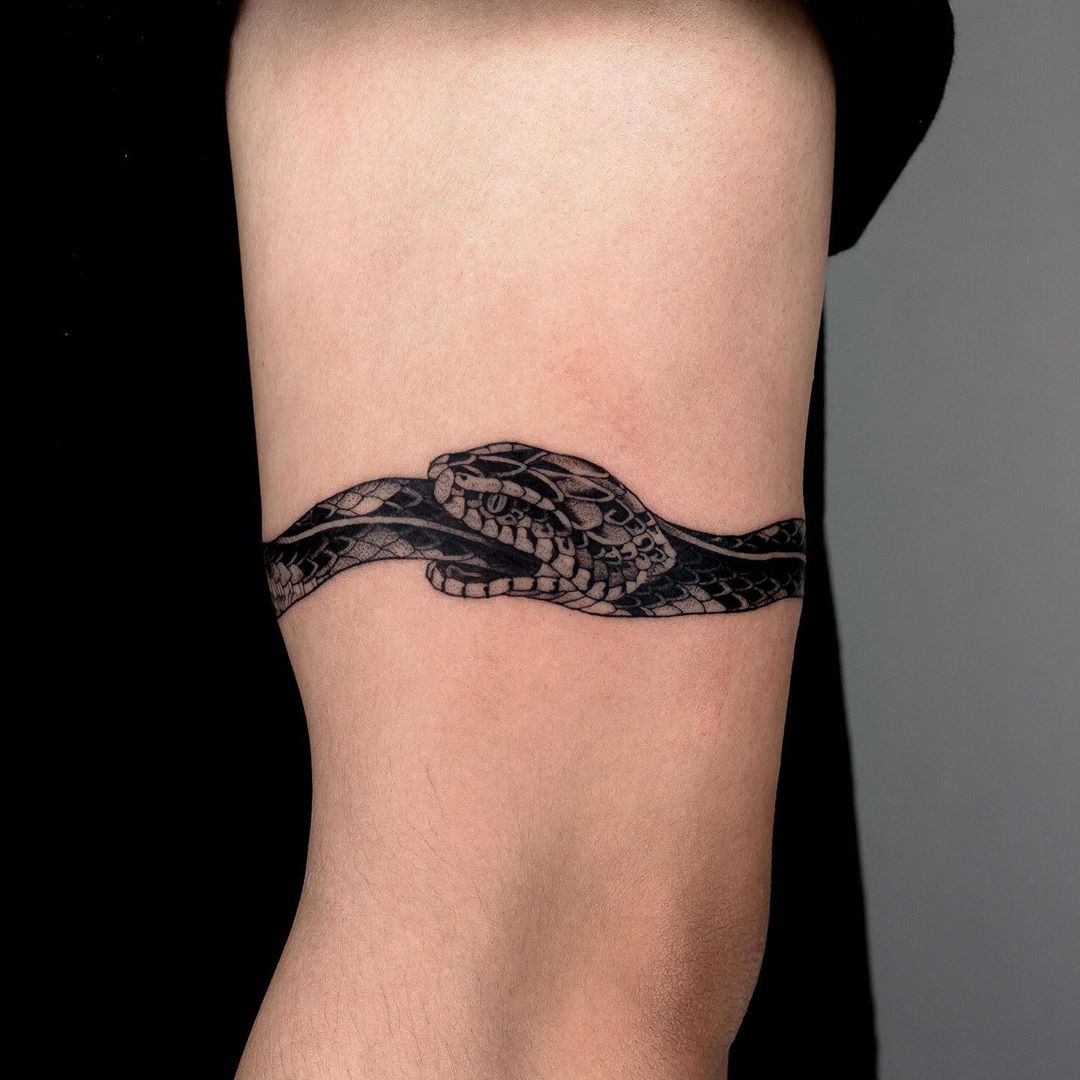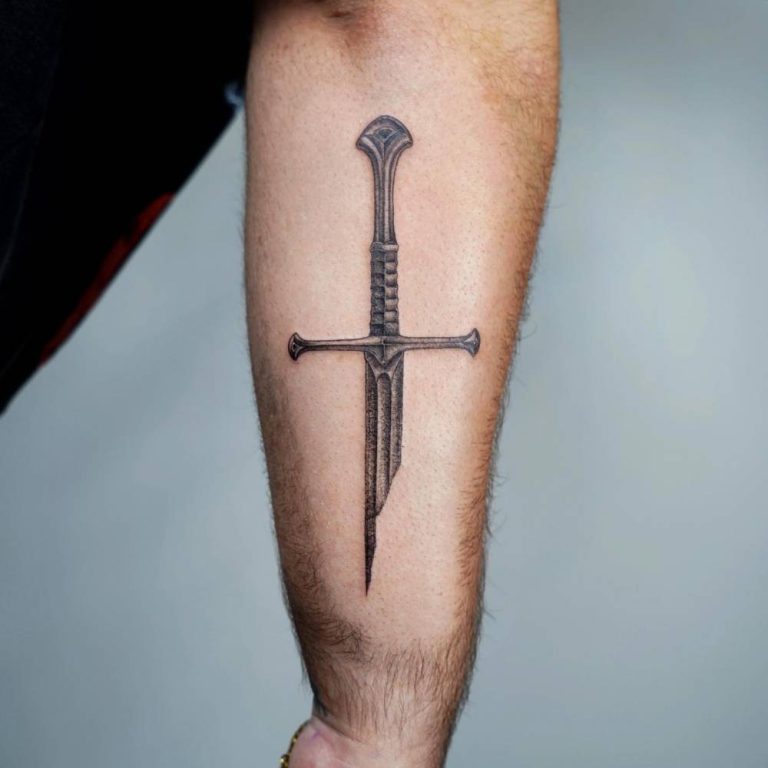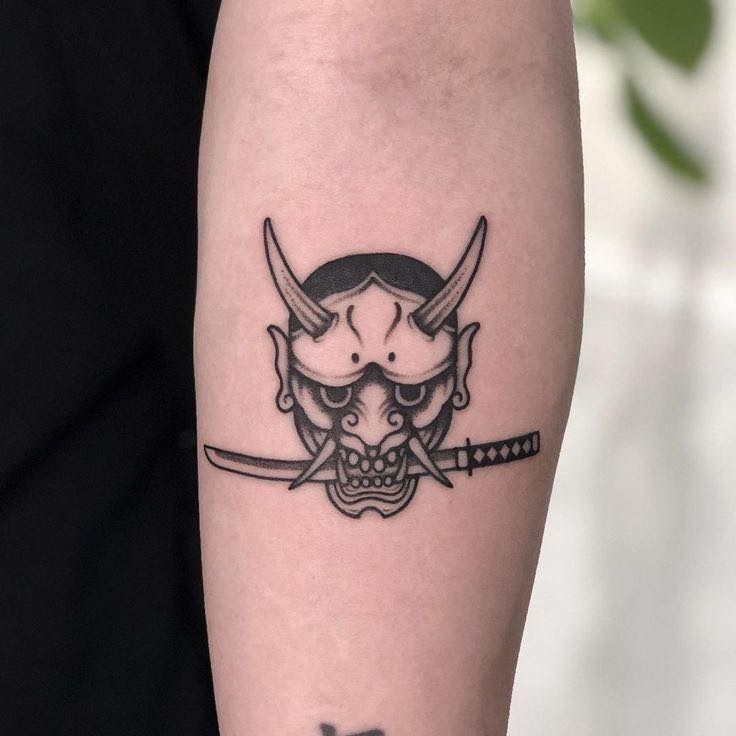
Decoding the Ouroboros Tattoo: Symbols and Meanings
The Origin and History of the Ouroboros Symbol
The ouroboros tattoo symbolizes infinity and the cycle of life and death. This ancient symbol first appeared in Egypt. It became known 3000 years ago in the ‘Enigmatic Book of the Netherworld’. This text belongs to King Tutankhamun’s tomb. The symbol shows a serpent or dragon eating its own tail. It represents the endless cycle and the idea of something constantly re-creating itself.
Other early sightings of the ouroboros symbol include ancient Greek and Roman iconography. The Greeks named it ‘Ouroboros’ meaning ‘tail devourer’. In alchemy, the ouroboros stood for the cycle of nature, the eternal return, and the soul of the world.
During the Renaissance, alchemists often used the ouroboros. They saw it as a symbol of unity and the relentless cycle of creation and destruction. The ouroboros also appeared in various religious and mythological texts. Its meanings expanded to include themes of birth, death, and rebirth.
In modern times, the ouroboros remains a powerful symbol. It appears in books, movies, and as tattoos. When people choose an ouroboros tattoo, they connect with its rich history and deep symbolism that spans many eras and cultures.
Variations of the Ouroboros Tattoo
The ouroboros tattoo can vary greatly in its design and style. From the classic depiction of a snake or dragon encircling itself, artists have created diverse interpretations that add personal meaning or cultural significance. Below, we discuss some common variations seen in ouroboros tattoos.
- Dual Serpent Ouroboros: Sometimes, the tattoo features two serpents intertwined, symbolizing duality and balance.
- Dragon Ouroboros: Instead of a serpent, the creature may be depicted as a dragon, drawing on stronger mythological themes.
- Floral Ouroboros: Incorporating flowers or vines, this variation often signifies growth and life within the eternal cycle.
- Tribal Ouroboros: With bold lines and patterns, this style connects to ancient tribal ceremonial practices and symbolism.
- Minimalist Ouroboros: A simple and sleek design that focuses on the essential shape of the symbol, for a modern and subtle tattoo.
- Geometric Ouroboros: Using shapes and symmetry, this variation can represent the perfection and precision of nature’s cycles.
Each variation has its attributes and lends a different aspect to the core meaning of the ouroboros symbol, allowing the wearer to align the tattoo with personal beliefs or aesthetic preferences. Regardless of the style, the ouroboros tattoo remains a profound emblem of the cyclical nature of the universe and our existence within it.

Common Themes and Interpretations
The Ouroboros tattoo holds various meanings across different contexts. Drawing from historical texts and cultural beliefs, here are some common interpretations:
- Eternal Cycle: This core theme represents the cyclical nature of the universe, embracing concepts such as birth, death, and rebirth.
- Infinity: The Ouroboros is often seen as a symbol of the infinite, with no beginning or end, much like how it appears physically.
- Self-reflexivity: It can denote self-reflection, growing and consuming one’s self to create constant renewal.
- Unity and Wholeness: Encircling its tail, the Ouroboros depicts the unity of all things, suggesting that life is interconnected.
- Duality: The merging of the beginning and the end in one symbol hints at the duality of existence, combining opposing forces into a balanced whole.
Interpreters of the Ouroboros often find personal significance in these themes, seeing them as reflections of their own lives or broader philosophical ideas. On a deeper level, it might symbolize the individual’s journey to self-realization or the quest for unity in different aspects of life. The Ouroboros tattoo can act as a personal reminder of perpetual evolution, the importance of introspection, or a connection to the cosmic cycle. Perfect for those who find meaning in life’s continuous loop and the interconnectedness of all things, the Ouroboros serves as a powerful personal symbol.
Incorporating the ouroboros tattoo into one’s skin is a testament to accepting and embracing these universal themes, which have captivated minds for centuries and continue to inspire to this day.
The Ouroboros in Different Cultures
The ouroboros tattoo represents a universal concept, but it holds unique meanings in different cultures. Its ability to adapt to various civilizations makes the ouroboros tattoo even more compelling.
- Egyptian Culture: In ancient Egypt, where the ouroboros first appeared, it symbolized the cyclical nature of life and the sun’s journey across the sky.
- Greek Civilization: For the ancient Greeks, the ouroboros was associated with the cycle of life, death, and rebirth. It also represented the idea of wholeness.
- Chinese Mythology: In Chinese culture, the ouroboros often becomes a dragon, embodying the balance of yin and yang, and the eternal nature of the universe.
- Nordic Lore: The ouroboros appears in Norse mythology as Jormungandr, a serpent that encircles the world, biting its own tail, reflecting the bounds of the Earth.
- Hindu Traditions: Within Hinduism, the circular nature of the ouroboros embodies the endless cycle of samsara, the repeating loop of life, death, and rebirth.
- African Interpretations: Some African myths use the ouroboros to represent the seasonal cycle and the balance of nature’s forces.
Each culture adds its layer of meaning to the ouroboros tattoo, enriching its symbolism. Individuals often choose a design that resonates with their cultural background or beliefs. The ouroboros’ widespread adaptation across cultures underlines its enduring appeal and its capability to convey deep, personal significance. It’s a testament to the symbol’s versatility and timelessness.

Placement and Design Considerations for Ouroboros Tattoos
When planning an ouroboros tattoo, placement and design are crucial factors. The tattoo’s location can affect its visibility and meaning, while the design determines its personal significance and aesthetic appeal. Here’s what to consider:
- Visibility: Choose a spot on your body where you want the tattoo to be seen. Popular areas include the wrist, forearm, and nape of the neck.
- Size and Detail: Larger tattoos can include more details, whereas smaller ones might need to be simpler to remain clear.
- Personal Meaning: The ouroboros tattoo’s placement might hold personal significance. For example, encircling an ankle or wrist could symbolize a personal boundary or cycle.
- Aesthetic: Consider how the ouroboros will look with other tattoos or against the tone of your skin. A well-thought-out placement can complement body shape and skin art.
- Pain Tolerance: Some body areas are more sensitive. If you have a low pain threshold, consider getting the tattoo where the skin is thicker.
Always consult with a professional tattoo artist. They can advise on the best placement and design to suit your body structure and skin tone. Remember, an ouroboros tattoo is not just a fashion statement; it’s a symbol with deep roots in history and culture.
The Ouroboros and Its Connection to Other Symbols
The ouroboros tattoo shares its cyclical symbolism with several other symbols. Each connected symbol adds depth to the ouroboros concept. Let’s explore some symbols and their links to the ouroboros.
- The Infinity Sign: Like the ouroboros, the infinity sign represents no beginning or end. It highlights endless possibilities and eternal existence.
- Yin and Yang: The interlocking black and white shapes depict balance. This connects with the ouroboros’ theme of duality and wholeness.
- The Phoenix: A mythical bird that rebirths from ashes, the phoenix symbolizes renewal and echoes the rebirth aspect of the ouroboros cycle.
- The Circle of Life: A concept seen across cultures, it signifies life’s stages, from birth to death to rebirth, much like the ouroboros.
- Ankh: The ancient Egyptian cross with a loop, it denotes life and death. The ouroboros, rooted in Egyptian imagery, shares this symbolism of life cycles.
Knowing these connections can deepen the understanding and personal meaning of an ouroboros tattoo. It’s not just a standalone emblem; it is part of a broader symbolism that reflects the complexities of life, death, and rebirth.

Popular Ouroboros Tattoo Styles
When selecting an ouroboros tattoo, style plays a key role. Each style offers a distinct look and can reflect your personal story or interests. Below are some popular ouroboros tattoo styles that stand out in the tattoo community:
- Traditional Style: This style uses bold lines and bright colors. It often features a classic serpent design, taking inspiration from old-school tattoos.
- Realistic Style: Artists create lifelike serpent or dragon ouroboros tattoos, focusing on natural details, shadows, and highlights.
- Watercolor Style: Watercolor tattoos bring a burst of color and an artistic feel. The ouroboros in this style appears like a painting on the skin.
- Blackwork Style: Using solid black ink, this style emphasizes the ouroboros’ shape and form. It offers stark contrast and dramatic effect.
- Dotwork Style: Composed of countless tiny dots, dotwork creates a unique texture. It blends well with the ouroboros’ circular nature.
- Abstract Style: Abstract ouroboros tattoos use creative forms and shapes. They offer a modern take on the ancient symbol.
Each style has its advantages, so choose the one that connects with you. Keep in mind the longevity of the design. Some styles may fade or blur over time more than others. Discuss with a skilled tattoo artist to find the right style for your ouroboros tattoo.
Choosing the Right Ouroboros Tattoo for You
Selecting the perfect ouroboros tattoo involves more than just design preference. Here are key factors to help guide your decision:
- Sense of Identity: Reflect on what the ouroboros symbolizes for you personally. Does it connect to your spiritual beliefs or life philosophy?
- Visual Appeal: Consider the artistic style that you’re drawn to. Whether it’s traditional, watercolor, or minimalist, choose a design that you’ll love for years to come.
- Cultural Resonance: If a specific culture’s interpretation of the ouroboros resonates with you, incorporate elements from that culture into your tattoo design.
- Location on the Body: Think about where on your body the tattoo will be. Make sure it’s a place that you’re comfortable with and that will give justice to the design.
- Longevity: Some tattoo styles withstand the test of time better than others. Discuss with your tattoo artist the durability of the style you like.
- Personal Story: Your tattoo can tell a personal story. Choose a version of the ouroboros that holds significant meaning in your life journey.
- Professional Advice: A skilled tattoo artist can provide insights on what works best for your skin tone, body shape, and size requirements.
Remember, an ouroboros tattoo is a profound symbol you will carry with you always. It’s important to choose one that aligns with who you are and the message you want to share through your body art. With careful consideration and the assistance of an experienced tattoo artist, you can make an informed decision that you’ll be content with for a lifetime.

